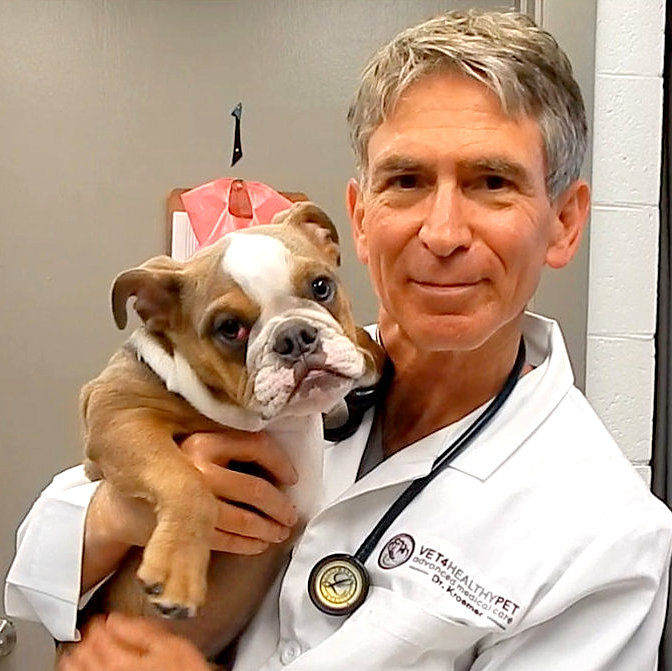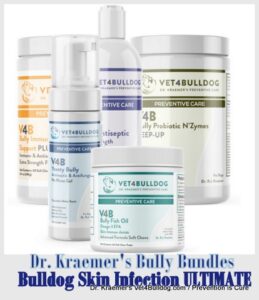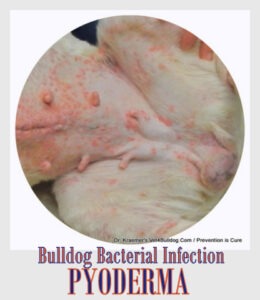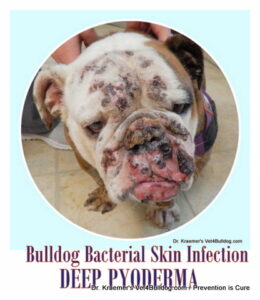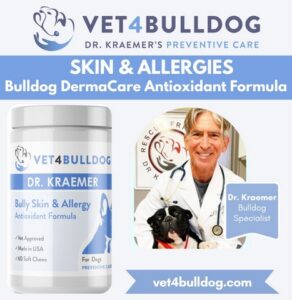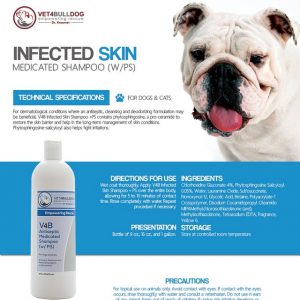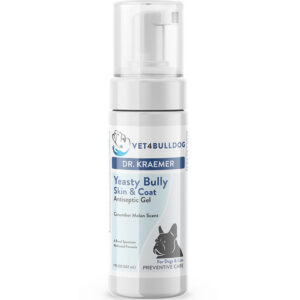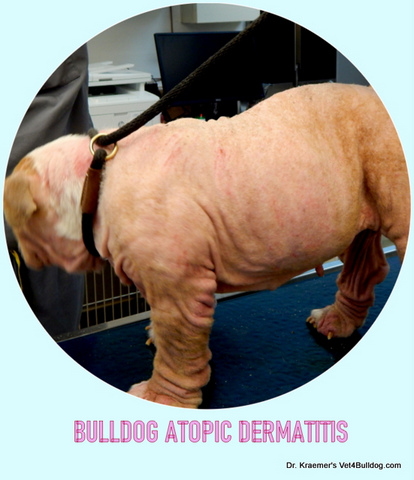Subject: Bella’s Bacterial Dermatitis 🐾😔 #BulldogHealth #SkinCare
Dr. Kraemer, I’m writing to express my concern about my beloved bulldog, Bella, who seems to be struggling with a bad skin infection. I’ve noticed Warm regards, The Smith Family & Bella the bully 🐶💖 #BulldogMom #SkinInfection
Introduction To Bulldog and Fr. Bulldog Skin Infection
Pyoderma is derived from Latin and stands for bacterial infection of purulent skin (pus). One of the most commonly recognized bacteria responsible for skin infections is Staphylococcus pseudointermedius.
These bacteria are usually part of the skin’s normal microflora, but when there’s an overgrowth or damage to the skin barrier, they can cause an infection.
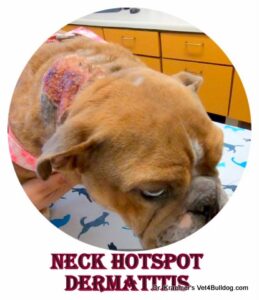
Bulldog Bacteria Skin Infection 5 X MUST KNOW
- There are three types: surface (mild/common), superficial (moderate/common), and deep (rare/severe).
- Due to the overuse of antibiotics, we see a higher number of multidrug-resistant bacterial infections.
- Antibiotics are not needed for surface pyoderma and often make the problem worse.
- Bully therapeutics should be used for all skin infections; they are often superior to medication.
- Prevention and care include Dr. Kraemer’s Bulldog Skin Infection Bundles.
Members of this bulldog community prefer prevention over RX
Skin Infections In Bulldogs PYODERMA TYPES:
There are three types of pyoderma: two are common, and the third is rare.
1. BULLDOG SURFACE SKIN INFECTION
Surface pyoderma, characterized by a bacterial infection of the skin surface, is often referred to as a “hot spot”.”
Typically, this infection is mild and can be effectively treated with nonprescription topical therapeutics.
The most commonly associated bacteria with surface pyoderma is Staphylococcus pseudointermedius.
2. BULLDOG SUPERFICIAL SKIN INFECTION:
It is a common bacterial infection within the skin, typically ranging from mild to moderate in severity. In some cases, prescription medication may be necessary based on cytology findings.
3. BULLDOG DEEP PYODERMA:
Deep pyoderma is a rare bacterial infection located beneath the skin. It is typically a more severe infection, often necessitating systemic antibacterial treatment.
Bulldogs affected by deep pyoderma can become ill and may require immediate medical attention.
What Causes Skin Infection in Bulldogs and Fr. Bulldogs?
There are a few underlying causes the most common of which are itching allergies that lead to an instability of the skin barrier and immune-compromised dog which effect the skin normal microbiome. Below is a short list of the main reasons leading to skin infection:
1. SKIN INFECTION DUE TO FAULTY GENETICS
There is evidence suggesting that genetic factors play a significant role in the predisposition of bulldogs to skin infections.
2. SKIN INFECTION DUE TO ALLERGIES:
Bulldogs are prone to allergies and skin diseases.
- Food allergy
- Atopic environmental allergy
- Flea allergy
- Contact allergy
Itching leads to skin injury, and damages the skin’s defensive barrier allowing secondary bacterial infections.
3. SKIN INFECTION DUE TO IMMUNE SUPPRESSION:
Drugs & Infections:
Various drugs suppress your bulldog’s immune system, the most common of which are:
- Cortisone: Steroids are immune suppressants.
- Chemotherapy: weakens the immune system and white blood cell count
Hormonal disease:
- Cushing: abnormally high endogenous cortisones.
- Hypothyroid: Low thyroid levels weaken the immune system
- Diabetes
Chronic Disease & Stress
- Parasitic infection: weakens the immune system
- Stress will suppress the immune system
- Poor nutrition
- Other chronic illness
Bulldog Skin Infections can Extend to The Ears and Wrinkles
The ears and wrinkles are the extension of the skin
1. SKINFOLD MOIST INFECTION DERMATITIS
- Face
- Nose
- Tail
- Vaginal
- Paws
2. BULLDOG ACNE
- Chin
- Lips
What Are The Symptoms of Skin Infections and Bulldog Pyoderma?
- Itching & Scratching
- Redness, puffiness, and inflamed Skin
- Baldness, Alopecia, and Hair Loss
- Oozing, draining tracks
- Pus lesions (Pustules)
- Pain
How To Diagnose Bulldog Pyoderma and Skin Infections?
- Exam
- Scrape: checking for mites
- Cytology: checking for inflammatory cells, yeast, and bacteria
- Allergy Testing: food trials and blood VARL test
- Fungal Culture
- Blood & Hormonal tests
- Culture & Sensitivity:
Culture is only required for unresolved infections that do not respond to antibiotic treatment.
Examples are:
- MRSP: the common staph bacteria that mutates and is no longer responsive to the common antibiotics.
- Gram-negative bacteria and other less common skin pathogens.
Skin Infection Bulldog Pyoderma PREVENTIVE CARE
- Identifying and managing the underlying immune suppressant disease
- Avoiding immune suppressant drugs
- A balanced, quality diet
- a stress-free, loving environment
- BULLDOG THERAPEUTICS:
- Topical bully Therapeutics
- Bully therapeutic Supplements
Bulldog and Fr. Bulldog Skin Infection TREATMENT
Treatment depends on the severity and type of the pyoderma
1. TREATING BULLDOG SURFACE SKIN INFECTION
BATHING: Bathing helps remove allergens and dead skin and is soothing
MEDICATED ANTISEPTIC SHAMPOO
- V4b Bully Extra Strength Antiseptic Shampoo
- V4B Yeasty Bully Antiseptic Medicated Shampoo
ANTISEPTIC SPRAY AND GELS
- Yeasty Bully Antiseptic No-Rinse Gel
- Hot Spot Bully Antiseptic Spray
IMMUNE & INFLAMMATION
- Bully Fish Oil
- Bully Immune Support
GUT MICROBIOME
- Bully Pre/Probiotics LOAD UP
- Bully Digestive Enzymes Probiotic KEEP UP
CALM & RELAX
- Bully StressLess
- Bully HEMP Calm
WARNING: Antibiotics are not recommended for surface skin infection; they are mostly ineffective and can compound the problem by selecting resistant bacteria and by its negative effect on the gut microbiome (good gut bacteria)
Bathing and bully therapeutics are usually all that is required.
2. TREATNG BULLDOG SUPERFICAL SKIN INFECTION
Bully therapeutic is often combined with antibiotics
- Bathing
- Antibiotics: based on cytology (cocci). Usually for 3–4 weeks
- Itch control RX
- Bully Therapeutics: same as a surface skin infection
Dr. Kraemer’s Bully Therapeutics BEFORE & AFTER
3. TREATING BULLDOG DEEP PYODERMA:
Deep skin infection requires antibiotics and often for multiple pathogens.
- Bathing
- Antibiotics are based on culture and sensitivity. Usually for 6–8 weeks
- Itch control RX
- Laser Therapy
- Stem Cell Therapy
- Bully Therapeutics: same as a surface skin infection
WARNING: The underlying condition such as an underlying immune suppression disease must be identified for the treatment to be effective.
- Hypothyroid: Thyroid tablets
- Cushing’s: Trilostane
- Parasites: Dewormings and Topical preventives
WARNING: Immune support cause is not always a disease. Often it’s due to overzealous use of cortisone such as for itch control
Bulldog Skin Infection: BENEFIT OF BULLY THERAPEUTIC
There are major advantages to the early and frequent use of bully therapeutics.
These advantages include:
- SPEED: Speeding the resolution of the skin infection
- RANGE: Limits multidrug-resistant bacteria
- WASH: Washing bacteria and allergens off the skin
- POTENT: Highly effective for superficial and surface pyoderma
- DURATION: Reduces the duration of antibiotic treatment
- MRSP: Effective against multidrug-resistant bacteria like MRSP
- KERATOLYTIC: Removes dander, scale, and flakes
- ITCHLESS: Soothing and itch relief
- HYDRATION: Hydrating the skin
- LOW COST
- NON-RX (no prescription is required)
- @ HOME
- EASY TO IMPLEMENT
- VERY SAFE
- NO SIDE EFFECTS
BULLY WATERLESS ANTISEPTIC GELS
Dr. Kraemer’s provides a medicated no-rise antiseptic gel for those pets who are difficult to bath or for those owners with limited time or who do not own a bathtub
Compliance is critical.
Bulldog and French Bulldog Skin Infection TIPS & WARNINGS
Below are selective pyoderma tips and warnings courtesy of Dr. Kraemer
#1. BULLY THERAPEUTICS TIP:
Prevention and management of any skin infection should always include topical therapeutics.
Most medicated shampoos must remain on the skin for at least 10 minutes before rinse.
#2. WATERLESS ANTISEPTIC GEL TIP:
Dr. Kraemer’s bully waterless no-rinse antiseptic gel can be used in between shampoo bathing days.
#3. BULLDOG STRESS & ANXIETY TIP:
Chronic stress and poor nutrition can suppress the immune system thus increasing the odds of pyoderma.
#1. SKIN INFECTION ANTIBIOTIC WARNING:
It is a widespread practice among veterinarians to prescribe empirical systemic antibiotics as the “go-to” treatment; it is often not required and, at times, harmful, always remember our “Do No Harm” cardinal rule
Topical nonprescription medicated therapy and baths should always be the default “go-to” treatment in surface and superficial pyoderma.
#2. SKIN INFECTION UNDERLINING CAUSE WARNING:
Addressing the underlying cause is crucial. If allergies are the root issue, it’s essential to control the itch. If the immune system is compromised, efforts should be made to address the underlying cause and boost the immune system through
- stress reduction,
- balanced diet
- appropriate therapeutic supplements
#3. SKIN INFECTION TREATMENT DURATION WARNING:
Antibiotic treatment usually requires a few weeks of treatment. If you stop the treatment too soon, the infection can reoccur or become more resistant to the common drugs.
#4. SKIN INFECTION CORTISONE WARNING:
Remember many of the itch control medications contain cortisone, which can make the infection worse
#5. SKIN INFECTION MULTIDRUG RESISTANCE WARNING:
Over the last decade, we have seen a steep rise in multidrug-resistant bacteria, mostly due to overuse or inappropriate use of antibiotics.
MRSP is the common Staphylococcus aureus that becomes resistant to the commonly prescribed antibiotics.
Skin Infection in Bulldogs and French Bulldogs SUMMARY:
All skin infections and pyodermas should include nonprescription bully therapeutics
Re-checks and follow-up exams are critical, especially for deep pyoderma cases
Trusted by Vets ~ Recommended by Owners ~Approved by Bulldogs



